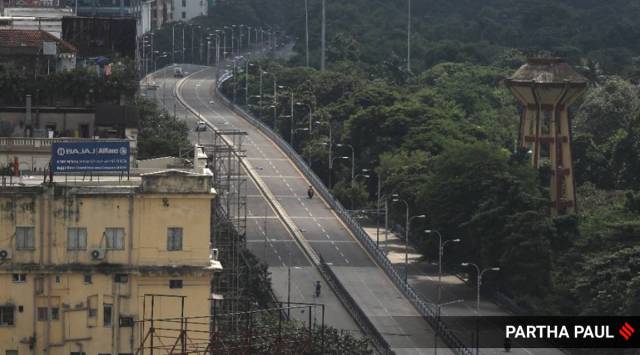- India
- International
CPCB analysis finds drastic fall in air pollution levels during lockdown
While the reduction in PM2.5 levels shows a 16 per cent improvement due to the lockdown regionally, the improvement in air quality was far higher in cities as compared to the rest of the country.
 With transportation, industries, commercial activities, construction etc halting in cities, the air quality showed an improvement.
With transportation, industries, commercial activities, construction etc halting in cities, the air quality showed an improvement.The Central Pollution Control Board (CPCB) on Wednesday released the results of an analysis it carried out to assess the reduction in air pollution during the lockdown.
The CPCB has found a drastic fall in pollution levels and an improvement in the Air Quality Index (AQI) of Delhi and its neighbouring towns of Faridabad, Gurugram, Noida and Ghaziabad as well as in Mumbai, Bengaluru, Kolkata, Chennai, Indore, Patna and Singrauli.
Air quality data was studied in three stages — pre-lockdown (March 1-21), lockdown phase-I (March 25 – April 19) and lockdown phase-II (April 20 – May 3). A comparative analysis has also been done for the corresponding time periods in 2019 to assess the quantum of improvement during the stages.
While the reduction in PM2.5 levels shows a 16 per cent improvement due to the lockdown regionally, the improvement in air quality was far higher in cities as compared to the rest of the country. With transportation, industries, commercial activities, construction etc halting in cities, the air quality showed an improvement. But a similar impact was not felt in rural India.
In Delhi, the CPCB has found “significant reduction in PM2.5, PM10 and NO2” levels in the city. In terms of particulate matter levels, while PM2.5 reduced by 24 per cent during the pre-lockdown stage, it further reduced by almost 50 per cent during both lockdown phases as compared to levels observed during 2019. PM10 reduced by a massive 60 per cent, with NO2 levels falling by 64 per cent, Benzene by 62 per cent and SO2 by 35 per cent during the second phase of lockdown as compared to levels in the same time period in 2019.

The pre-lockdown period in Mumbai actually had higher PM2.5, PM10, NO2 and SO2 levels compared to 2019, which has been attributed to increased industrial and vehicular activity. But once the lockdown was imposed, a reduction of 68 per cent in SO2 levels, 56 per cent in NO2 levels and 20 per cent reduction in PM10 levels were seen during phase-I of the lockdown, against the 2019 levels.
The reduction in NO2 and PM10 levels further increased in the second phase of the lockdown to 69 per cent and 40 per cent respectively, when compared to the same time period in 2019.
Interestingly PM2.5 levels increased in the first phase of lockdown by 5 per cent but decreased by 9 per cent in the second phase of lockdown, as compared to levels during 2019, ostensibly because of tightening of lockdown restrictions by Maharashtra from April 22, when Covid-19 cases started surging.
Overall, a 29 per cent reduction in PM2.5 and 41 per cent reduction in PM10 was observed during the first phase of the lockdown period, which further increased to 47 per cent reduction in PM2.5 and 59 per cent reduction in PM10 in phase-II of lockdown, as compared to pre-lockdown levels.
Like Mumbai, most other cities have shown a sharper decrease in pollution levels in the second phase of the lockdown. In Kolkata, NO2, PM2.5, PM10 and Benzene levels saw reduction in all three stages against the levels observed in 2019, “with the quantum of reduction improving in each stage for most of the pollutants”, the CPCB analysis said.
During the second phase of lockdown, over 58 per cent reduction in PM2.5 and 68 per cent in PM10 levels were observed, compared to 2019 levels, which is higher than the 31 per cent and 36 per cent reduction for the same pollutants seen in the first phase of lockdown. Further, a 63 per cent reduction in NO2 levels and 51 per cent reduction in Benzene levels was observed during phase-II of lockdown, indicating the reduction in the number of on-road vehicles.
Like Mumbai, as cases started to surge in the second half of April in Kolkata, the administration imposed stricter lockdown norms, resulting in a more effective improvement in AQI. Kolkata witnessed 12 “good” AQI days during the 40-day lockdown period as opposed to 4 “good” days in the same period last year.
Bangalore witnessed a 48 per cent reduction in PM10 and 59 per cent reduction in PM2.5 in its second phase compared to 2019. Due to the restrictions imposed on vehicular movement and industrial activity, a 57 per cent reduction in NO2 levels and 54 per cent reduction in Benzene levels was observed during phase-II of lockdown, down from 67 per cent and 76 per cent reduction in the first phase compared to 2019.
Interestingly, the SO2 levels in Bengaluru actually increased during the lockdown period, indicating the use of biomass fuel in households and even industries.
While Patna saw an overall reduction of 60 per cent in PM2.5 and 70 per cent in NO2 during the second phase, in its first phase, the city only witnessed a 19 per cent reduction in PM2.5 and an actual increase of NO2 by 20 per cent from 2019, which is being attributed, among other possible factors, to the increased vehicular movement due to reverse migration.
Apr 19: Latest News
- 01
- 02
- 03
- 04
- 05






































